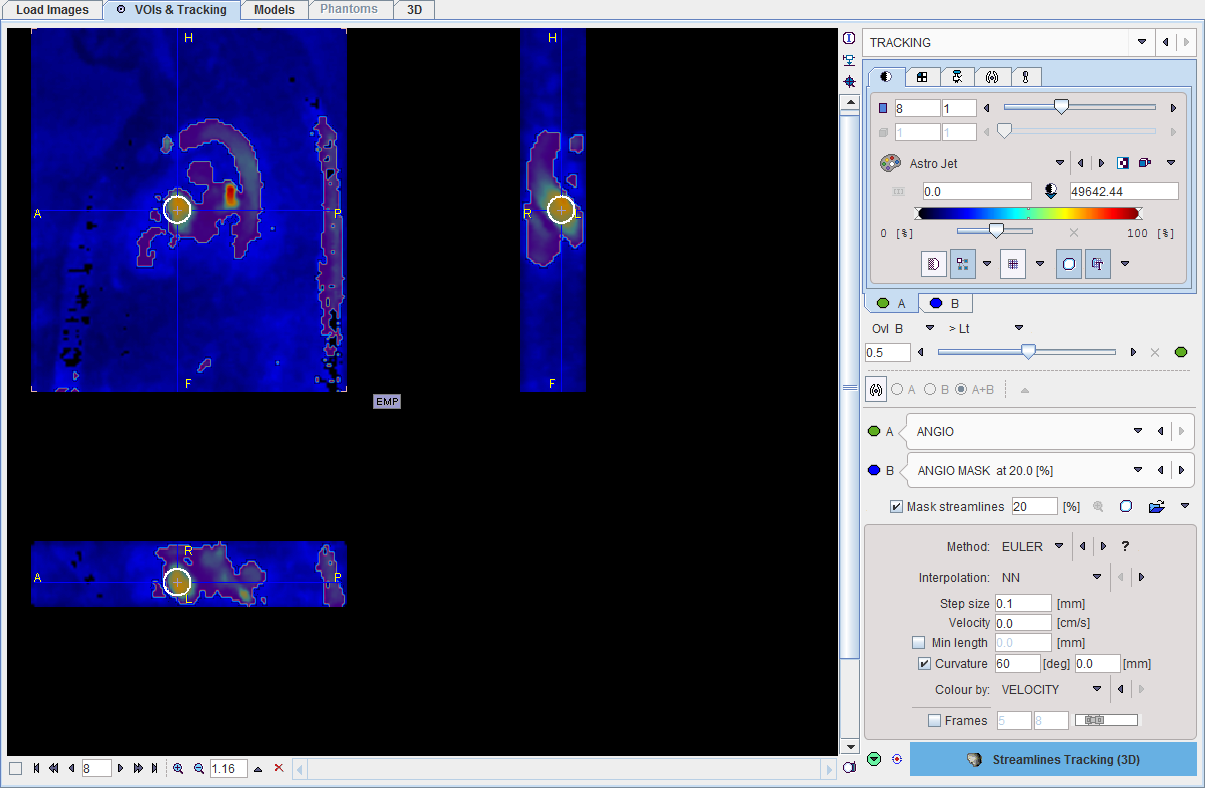When arriving at the TRACKING page, the image area shows a fusion of the Angio image (A) and the masked Angio image for highlighting areas with high flow. Also shown in the overlay are the VOIs.

Tracking Configuration
The area in the lower right serves for defining the tracking algorithm and its parameters. Three algorithms are supported and can be selected in the Method list:
The Interpolation setting is not relevant for FACT. For EULER and RK4 the choices are
Further parameters and options determine how tracking proceeds and when it ends:
Step size |
Distance between points on the streamlines. Not used for FACT as it does not apply interpolation. |
Velocity |
Track ends if the velocity amplitude drops below this threshold. |
Min length |
If checked, streamlines shorter than the minimal length specified are discarded. |
Curvature |
If checked, streamlines are terminated in case the curvature exceeds the specified angle within the length specified. If length = 0.0, the curvature is checked at each step. |
Exclusion VOI entry |
Defines the behavior, when a streamline enters an EXCLUDE VOI: DISCARD the whole track, or CLIP it at the entry point. |
Colour by |
The streamlines can be functionally colored as follows: |
Streamline Masking
An additional means for restricting the generated streamlines is by checking the Mask streamlines box and defining a mask. The elements in

have the following functionality:
|
Generate a mask from the ANGIO image by applying the specified threshold and include it in the image list B for viewing. |
|
Open the current mask in the VOI editor and convert it into a VOI. The VOI can be edited, and the mask finally updated from the VOI. |
|
Select an external mask file. |
Note: Please first perform tracking without streamline masking, and only afterwards gradually increase masking, if necessary.
As tracking is relatively time-consuming, it can optionally be restricted to a certain section of the acquisition with the Frames selection

After configuring all tracking parameters, please proceed with the  button. The streamlines are calculated and visualized on the 3D page.
button. The streamlines are calculated and visualized on the 3D page.
References
[1] Mori S, Crain BJ, Chacko VP, van Zijl PC: Three-dimensional tracking of axonal projections in the brain by magnetic resonance imaging. Ann Neurol 1999, 45(2):265-269.
[2] Basser PJ, Pajevic S, Pierpaoli C, Duda J, Aldroubi A: In vivo fiber tractography using DT-MRI data. Magn Reson Med 2000, 44(4):625-632.
[3] Behrens TE, Woolrich MW, Jenkinson M, Johansen-Berg H, Nunes RG, Clare S, Matthews PM, Brady JM, Smith SM: Characterization and propagation of uncertainty in diffusion-weighted MR imaging. Magn Reson Med 2003, 50(5):1077-1088. DOI